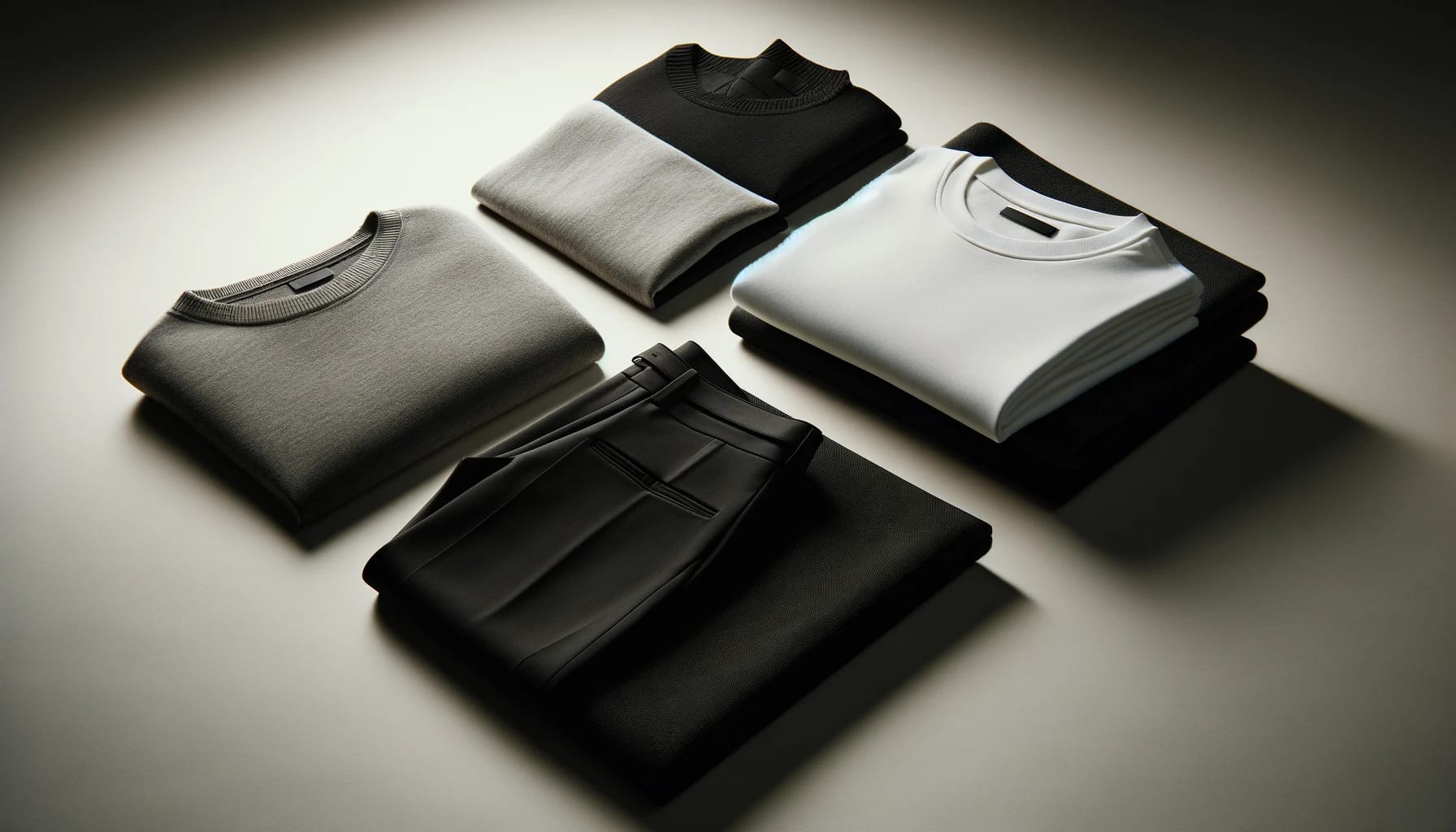Imagine your wardrobe as a treasure trove of untold stories, each article a testament to the passage of time. From the T-shirt, a symbol of nonchalance and comfort, to denim, a fabric that’s evolved from humble origins to become a global icon, the clothes we wear hold a wealth of fascinating details and captivating narratives. Let’s unravel the enigmatic tapestry of fashion history and discover the hidden gems that make our wardrobe so much more than meets the eye.
Fascinating Facts About Commencement Clothing
You know how sometimes you stumble upon a brand and think, “Where have they been all my life?” Commencement Clothing might just be that brand for you. Founded in 2005, this company has been quietly making waves in the fashion world, and their story is pretty interesting.
One of the things that sets Commencement Clothing apart is its commitment to sustainability. We’re talking eco-friendly materials like organic cotton and recycled fabrics. It’s refreshing to see a company that cares about the planet as much as they care about style.
Now, you might think that all this sustainability comes with a hefty price tag, right? Well, here’s the kicker: Commencement Clothing is surprisingly affordable. They’ve managed to find that sweet spot between quality and price, which is probably why their popularity has skyrocketed.
But what really makes Commencement Clothing stand out is their commitment to inclusivity. They believe everyone deserves to look and feel their best, regardless of their shape, size, or style. Their designs cater to a diverse range of body types, so you can finally say goodbye to those frustrating fitting room moments.
And the best part? People love them! Just take a peek at their online reviews – you’ll see customers raving about the quality, the fit, and the feel-good factor of wearing something that’s both stylish and sustainable.
Key Points about Commencement Clothing:
- Founded in 2005, focused on eco-friendly materials and sustainable practices.
- Offers affordable, high-quality fashion made from organic cotton and recycled fabrics.
- Has gained popularity with both everyday consumers and celebrities.
- Collaborates with renowned designers for exclusive collections.
- Commitment to inclusivity, catering to diverse body types and styles.
- Receives positive customer reviews praising quality, fit, and sustainability.
- Demonstrates that fashion can be both stylish and ethical.
What are some interesting facts about fashion?
We’ve already talked about how cool fashion is, but did you know it has a whole backstory filled with interesting twists and turns? Let’s dive into some fascinating facts about the clothes we wear!
- Fashion Through the Ages: Fashion isn’t a new thing. Think ancient Egypt – they were rocking linen outfits that screamed, “Look at my status!” From those fancy robes Roman emperors wore to the elaborate attire of the Renaissance, clothing has always been a reflection of the times and the cultures rocking them.
- The Language of Clothes: Have you ever heard the saying “clothes make the statement”? Well, it’s true! What we wear goes beyond just covering up. It’s like a secret language, providing glimpses into who we are and where we’re from. Consider this: some cultures use colors or specific clothes to show social status or religious beliefs.
- Shaping the Industry: Remember sewing machines? They were a total game-changer for fashion! And don’t even get us started on synthetic materials – talk about revolutionizing the industry! But technology isn’t the only thing shaking things up. Cultural shifts, like the rise of unisex clothing or the push for sustainable fashion, heavily influence what we wear and how it’s made.
- Trendsetters and Tastemakers: Ever heard of Coco Chanel or Yves Saint Laurent? These design legends didn’t just create clothes; they sparked entire fashion movements! And let’s not forget about the power of celebrities and street style – they’ve become major players in setting trends and influencing what we see in stores.
Key Takeaways:
- Historical Roots:
- Fashion has existed for centuries, with ancient cultures such as Egypt, Greece, and Rome having distinct clothing styles.
- The loincloth is considered the oldest form of clothing, followed by the skirt.
- Social and Cultural Significance:
- Clothing can indicate social status, wealth, and cultural affiliation.
- In some societies, certain colors were restricted to specific groups, such as purple being reserved for royalty.
- Evolution Through Innovation:
- Technological advancements have transformed fashion techniques and materials.
- Cultural shifts have influenced fashion trends, such as the rise of unisex clothing.
- Icons and Influence:
- Designers like Coco Chanel and Levi Strauss have created iconic and enduring fashion items.
- Street fashion and celebrity culture have had a significant impact on fashion trends.
Emerging Trends and Future Insights:
- Sustainability in Fashion: The environmental impact of fashion has become a growing concern, leading to the emergence of sustainable and eco-friendly practices.
- Fashion as a Form of Protest: Clothing has often been used to express political and social messages, from suffragette outfits to activist attire.
- Psychological Impact of Clothing: Studies suggest that the clothes we wear can influence our mood and behavior.
- Cross-Cultural Exchange in Fashion: Globalization and increased cultural interactions have led to the fusion of fashion styles and influences from different regions.
Where is Commense headquarters?
You might be wondering where all the magic happens, right? Where do the fashion gurus behind Commense cook up their stylish creations? While the provided text focuses on Commencement Clothing, “Commense” likely refers to a popular online fashion retailer.
Commense, known for its trendy and affordable pieces, operates globally, shipping to over 50 countries. They have a strong online presence and are known for having positive customer reviews.
If you’re interested in checking out their offerings or learning more, you can explore their website or social media platforms.
Key Points about Commense:
- A popular online women’s fashion retailer with a solid reputation.
- Headquartered in Boston, but operates globally, shipping to over 50 countries.
- Emphasizes sustainability and offers a wide range of stylish and affordable pieces.
Remember: While Commense has a strong reputation, thorough research and vigilance are recommended before making purchases from any online retailer.
Did you know clothes facts?
We’ve been chatting about the cool stories behind the clothes we wear, and get this – there’s even more to uncover! Ready for some more “whoa, I didn’t know that” moments about your wardrobe? Let’s dive in:
- The T-shirt’s Undercover Past: The T-shirt, that symbol of casual cool, started its life as underwear for U.S. Navy sailors back in the 1910s. But here’s the thing: it wasn’t an instant hit as outerwear. It took its sweet time becoming the icon it is today. Some fashion historians suggest its popularity boom didn’t really happen until the mid-20th century, thanks to Hollywood heartthrobs rocking the simple tee.
- Denim’s Global Roots: We know Levi Strauss introduced blue jeans in 1873 for miners and cowboys who needed tough, long-lasting pants. But the fabric itself, denim, has a history dating back even further. Some believe it originated in the French city of Nîmes, while others point to Italy as its birthplace. It’s a denim debate for the ages! What’s certain is that denim’s journey from workwear to fashion staple is a testament to its versatility.
- The Little Black Dress: A Timeless Classic: Coco Chanel gets a lot of credit for making the little black dress (LBD) big in the 1920s, capturing the changing mood of women embracing a new era of independence. But the idea of a simple, elegant black dress predates her. The LBD is a reminder that fashion isn’t just about clothes; it’s about reflecting who we are and how we want to be seen.
- The Zipper’s Unsung Importance: It’s easy to take this little invention for granted, but before Whitcomb Judson came along in 1893, people were stuck with buttons and laces. Imagine! While his first version wasn’t perfect (they were known to pop open – yikes!), it paved the way for the zippers we rely on today.
- The Bra: A Revolution in Undergarments: Mary Phelps Jacob patented the bra in 1914. But the pursuit of a comfortable and supportive undergarment for women has been going on for centuries. What started as corsets and other restrictive garments gradually evolved into what we know today. The bra’s story is intertwined with women’s changing roles in society and their fight for comfort and freedom.
The world of clothing is full of fascinating tales waiting to be told. Next time you’re getting dressed, take a moment to appreciate the history woven into every seam and button.
What are some fun facts about clothes for kids?
Kids’ clothes are more than just adorable outfits. They’re a reflection of childhood itself, offering comfort, safety, and a powerful way for little ones to express their personalities and unique style! But did you know that clothes can also be a window into different cultures and a trip back in time? Let’s explore some fascinating facts about kids’ fashion.
Think back to when you were a kid – bright colors and fun patterns were like a burst of sunshine, right? It’s no surprise that kids’ clothes tend to be way more colorful and playful than what we adults wear.
Over time, people started realizing that clothes could be more than just a necessity. They could be a way to express themselves and their cultural identity. Fast forward to today, and the clothing industry is a massive, ever-evolving world!
Now, let’s talk fabric! Clothes can be made from so many different materials, each with its own unique feel and purpose. Natural fabrics like cotton, wool, and silk have been popular choices for centuries because they’re breathable and feel great against the skin. Then we have synthetic fabrics like polyester and nylon, which are super durable, wrinkle-resistant, and perfect for busy kids on the go.
Think about all the cool designs and decorations you see on clothes! Embroidery, printing, beading – it’s like each piece of clothing is a mini work of art. And don’t even get me started on the endless possibilities of buttons, zippers, and other embellishments!
But here’s the thing about clothes – they’re not just about looking good. They’re a powerful tool for self-expression, especially for kids. Through their clothing choices, kids can tell the world who they are, what they love, and what makes them unique. Whether it’s a shirt with their favorite superhero, a dress that twirls perfectly, or a whole outfit that screams “Look at me, world!”, clothes give kids a voice.
Here are some more fun facts about kids’ clothing that might surprise you:
- Did you know that the average American child owns a whopping 200 articles of clothing? That’s a whole lot of outfits!
- It’s no surprise that blue is the most popular color for kids’ clothes – it’s a calming and classic choice.
- When it comes to style, jeans and a t-shirt reign supreme as the ultimate comfy and cool outfit for kids everywhere.
- We’ve all been there – kids grow out of their clothes faster than we can keep up! On average, kids outgrow their clothes every 6 to 12 months.
What are some interesting facts about fast fashion?
We all like a good deal on a trendy outfit, but have you ever stopped to think about what goes on behind the scenes in the world of fast fashion?
- A Thirsty Industry: Did you know that making just one pair of jeans takes a whopping 2,000 gallons of water? That’s enough to make you think twice about your next denim purchase! The fast fashion industry uses a massive 93 billion cubic meters of water each year.
- Labor Concerns: The way workers are treated is another major concern. It’s estimated that a staggering 93% of fast fashion brands don’t pay their garment workers a living wage. This means millions of people who make our clothes are trapped in a cycle of poverty, often facing unsafe working conditions and unfair treatment.
- Overproduction and Its Consequences: The fashion industry produces a mind-blowing 150 billion garments every year! That’s nearly 20 pieces of clothing for every single person on Earth! All those unsold clothes often end up in landfills, releasing harmful greenhouse gases into the atmosphere.
- Environmental Impact: Did you know that the fast fashion industry is responsible for a shocking 8-10% of global greenhouse gas emissions? That’s more than the entire aviation and shipping industries combined!
So, next time you’re tempted by that trendy top or those must-have shoes, take a moment to consider the real cost of fast fashion. Your choices, as a conscious consumer, can truly make a difference.
What is special about fashion?
We’ve talked about how big the fashion world is and how much it impacts our lives, but what makes it so unique?
- Fashion as Self-Expression: Fashion is like a secret language we wear, a way to tell the world who we are without saying a word. From a power suit that screams “I’m the boss!” to a flowy dress whispering “free spirit,” our clothes become an extension of ourselves.
- A Canvas for Creativity: Fashion designers are like artists, using fabrics and cuts like paints and brushes. They imagine, they experiment, they push boundaries, and sometimes, they completely revolutionize the way we see clothes.
- Economic Impact: Let’s not forget the economic engine that fashion represents. It’s a global industry creating millions of jobs, from the talented seamstresses to the charismatic salespeople. It’s a whirlwind of trends and seasons, constantly changing and evolving, keeping us on our toes and fueling the economy.
So, the next time you put together an outfit, take a moment to appreciate the artistry, the individuality, and the sheer impact of the fashion world. It’s more than just clothes; it’s a cultural phenomenon with the power to inspire, empower, and, yes, even change the world.
What are some fun facts about fashion designers?
Fashion designers are the artists of the wearable, transforming simple fabrics into expressions of creativity. But there’s more to them than meets the eye – let’s uncover some intriguing tidbits about these style gurus!
Where do they get their inspiration?
You might be surprised to know that inspiration can strike a fashion designer from practically anywhere! It’s not just about flipping through glossy magazines. A walk in the park, a visit to an art museum, even a glimpse of a vintage button – these everyday things can spark an idea that blossoms into a stunning collection.
It’s not all glamour and runway shows, there’s a lot of work involved!
While we often see fashion designers at the peak of their careers, strutting down the runway with their muses, the reality is that countless hours of hard work go into each and every design. Behind the scenes, you’ll find them sketching tirelessly, hunched over sewing machines, and experimenting with different fabrics and textures.
It takes a Village…of Talented Artisans!
Creating a fashion collection is rarely a solo endeavor. Fashion designers often work closely with a team of skilled artisans – pattern makers, seamstresses, tailors, and more – each contributing their expertise to ensure the final product is flawless.
It’s not just about looking good, comfort matters too!
While aesthetics are undoubtedly important in fashion, designers also recognize the significance of functionality and wearability. They consider how a garment will move with the body, how it feels against the skin. A truly great fashion designer understands that true style is about feeling confident and comfortable.
Why is fashion important 3 reasons?
Our clothes are so much more than just something to keep us warm. It’s fascinating how fashion dives deep into our cultures, our social circles, and even our own personal journeys. As we move through time, fashion moves with us, shifting and changing to show off what we value, what we dream about, and who we are.
Fashion empowers self-expression
Fashion is an amazing tool we can use to express ourselves without even saying a word. Our clothing choices become a visual language, a way to tell the world, “This is me!” This freedom to express yourself through your wardrobe can be a real confidence booster, too! It allows us to tap into our creativity and embrace what makes us unique.
Fashion is a form of communication
What we wear speaks volumes even before we open our mouths. It’s like our clothes are having a conversation with the world around us, sending signals about our personality, our mood, maybe even our place in society.
Fashion has a cultural impact
Fashion acts like a mirror, reflecting the values, beliefs, and even the dreams of a particular time and place. It can be a powerful tool for breaking down barriers and celebrating diversity by embracing a beautiful mix of cultural influences.
It’s important to remember that our understanding of fashion’s impact is always developing. Researchers are constantly exploring new angles and interpretations. For instance, some studies suggest that certain colors and styles can influence our emotions and behavior. There’s also ongoing discussion about the environmental impact of fast fashion and a growing movement towards sustainability.
While we might not have all the answers yet, one thing is clear: fashion is more than just clothes; it’s a powerful force intertwined with our personal lives, our communities, and the world around us.
Check out these amazing facts about Cessna planes which will blow your mind or find intriguing facts about Brazilian men that you never knew. Also, we have interesting facts about McDonalds that you can’t miss.
- Unveiling the Enigma: Mansoureh Khojasteh Bagherzadeh’s Public Appearances & Private Life in Iran - July 18, 2025
- Unveiling the Mystery: Mansoureh Khojasteh Bagherzadeh’s Husband: A Rare Glimpse into a Private Life - July 18, 2025
- Unveiling Masoud Khamenei’s Mother: Power, Influence, and Iran’s Future - July 18, 2025
















